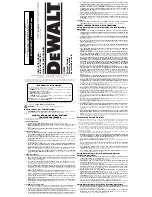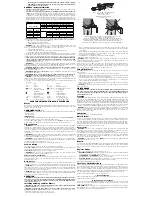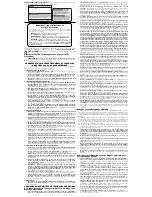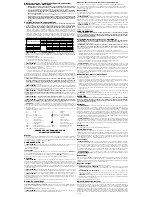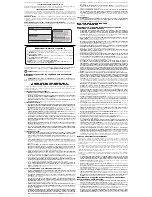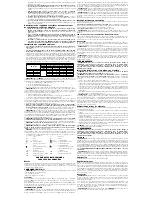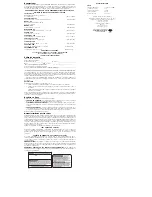
INSTRUCTION MANUAL
GUIDE D'UTILISA
TION
MANUAL DE INSTRUCCIONES
DW880
Straight Grinder
Meuleuse dr
oite
Esmeriladora r
ecta
INSTRUCTIVO DE OPERACIÓN, CENTROS DE SER
VICIO Y PÓLIZA DE
GARANTÍA.
ADVER
TENCIA:
LÉASE ESTE INSTRUCTIVO ANTES DE
USAR EL PRODUCTO.
Defi nitions: Safety Guidelines
The definitions below describe the level of severity for each signal word. Please read
the manual and pay attention to these symbols.
DANGER:
Indicates an imminently hazardous situation which, if not avoided,
will
result in
death or serious injury
.
WARNING:
Indicates a potentially hazardous situation which, if not avoided,
could
result in
death or serious injury
.
CAUTION:
Indicates a potentially hazardous situation which, if not avoided,
may
result in
minor or moderate injury
.
NOTICE:
Indicates a practice
not related to personal injury
which, if not
avoided,
may
result in
property damage
.
IF YOU HAVE ANY QUESTIONS OR COMMENTS ABOUT THIS OR ANY D
E
WALT TOOL, CALL
US TOLL FREE AT:
1-800-4-D
E
WALT (1-800-433-9258)
.
WARNING:
To reduce the risk of injury, read the instruction manual.
General Power Tool Safety Warnings
WARNING! Read all safety warnings and all instructions.
Failure to follow the warnings
and instructions may result in electric shock, fire and/or serious injury.
SAVE ALL WARNINGS AND INSTRUCTIONS
FOR FUTURE REFERENCE
The term “power tool” in the warnings refers to your mains-operated (corded) power tool or battery-
operated (cordless) power tool.
1) WORK AREA SAFETY
a)
Keep work area clean and well lit.
Cluttered or dark areas invite accidents.
b)
Do not operate power tools in explosive atmospheres, such as in the presence of
flammable liquids, gases or dust.
Power tools create sparks which may ignite the dust or
fumes.
c)
Keep children and bystanders away while operating a power tool.
Distractions can
cause you to lose control.
2) ELECTRICAL SAFETY
a)
Power tool plugs must match the outlet. Never modify the plug in any way. Do not
use any adapter plugs with earthed (grounded) power tools.
Unmodified plugs and
matching outlets will reduce risk of electric shock.
b)
Avoid body contact with earthed or grounded surfaces such as pipes, radiators,
ranges and refrigerators.
There is an increased risk of electric shock if your body is earthed
or grounded.
c)
Do not expose power tools to rain or wet conditions.
Water entering a power tool will
increase the risk of electric shock.
d)
Do not abuse the cord. Never use the cord for carrying, pulling or unplugging the
power tool. Keep cord away from heat, oil, sharp edges or moving parts.
Damaged
or entangled cords increase the risk of electric shock.
e)
When operating a power tool outdoors, use an extension cord suitable for outdoor
use.
Use of a cord suitable for outdoor use reduces the risk of electric shock.
f)
If operating a power tool in a damp location is unavoidable, use a ground fault
circuit interrupter (GFCI) protected supply.
Use of a GFCI reduces the risk of electric
shock.
3) PERSONAL SAFETY
a)
Stay alert, watch what you are doing and use common sense when operating a
power tool. Do not use a power tool while you are tired or under the influence of
drugs, alcohol or medication.
A moment of inattention while operating power tools may
result in serious personal injury.
b)
Use personal protective equipment. Always wear eye protection.
Protective
equipment such as dust mask, non-skid safety shoes, hard hat, or hearing protection used
for appropriate conditions will reduce personal injuries.
c)
Prevent unintentional starting. Ensure the switch is in the off position before
connecting to power source and/or battery pack, picking up or carrying the tool.
Carrying power tools with your finger on the switch or energizing power tools that have the
switch on invites accidents.
d)
Remove any adjusting key or wrench before turning the power tool on.
A wrench or
a key left attached to a rotating part of the power tool may result in personal injury.
e)
Do not overreach. Keep proper footing and balance at all times.
This enables better
control of the power tool in unexpected situations.
f)
Dress properly. Do not wear loose clothing or jewelry. Keep your hair, clothing and
gloves away from moving parts.
Loose clothes, jewelry or long hair can be caught in
moving parts.
g)
If devices are provided for the connection of dust extraction and collection facilities,
ensure these are connected and properly used.
Use of dust collection can reduce dust-
related hazards.
4) POWER TOOL USE AND CARE
a)
Do not force the power tool. Use the correct power tool for your application.
The
correct power tool will do the job better and safer at the rate for which it was designed.
b)
Do not use the power tool if the switch does not turn it on and off.
Any power tool
that cannot be controlled with the switch is dangerous and must be repaired.
c)
Disconnect the plug from the power source and/or the battery pack from the power
tool before making any adjustments, changing accessories, or storing power tools.
Such preventive safety measures reduce the risk of starting the power tool accidentally.
D
E
WALT Industrial Tool Co., 701 East Joppa Road, Towson, MD 21286
(JUL14) Part No. N407783 DW880
Copyright © 2002, 2004, 2005, 2007, 2011, 2014 D
E
WALT
The following are trademarks for one or more D
E
WALT power tools: the yellow and black color scheme; the
“D” shaped air intake grill; the array of pyramids on the handgrip; the kit box configuration; and the array of
lozenge-shaped humps on the surface of the tool.
If you have questions or comments, contact us.
Pour toute question ou tout commentaire, nous contacter
.
Si tiene dudas o comentarios, contáctenos.
1-800-4-D
E
W
A
L
T
• www
.dewalt.com
d)
Store idle power tools out of the reach of children and do not allow persons
unfamiliar with the power tool or these instructions to operate the power tool.
Power tools are dangerous in the hands of untrained users.
e)
Maintain power tools. Check for misalignment or binding of moving parts, breakage
of parts and any other condition that may affect the power tool’s operation. If
damaged, have the power tool repaired before use.
Many accidents are caused by
poorly maintained power tools.
f)
Keep cutting tools sharp and clean.
Properly maintained cutting tools with sharp cutting
edges are less likely to bind and are easier to control.
g)
Use the power tool, accessories and tool bits, etc. in accordance with these
instructions, taking into account the working conditions and the work to be
performed.
Use of the power tool for operations different from those intended could result
in a hazardous situation.
5) SERVICE
a)
Have your power tool serviced by a qualified repair person using only identical
replacement parts.
This will ensure that the safety of the power tool is maintained.
SAFETY INSTRUCTIONS FOR ALL OPERATIONS
Safety Warnings Common for Grinding and Wire Brushing
Operations
a)
This power tool is intended to function as a grinder or wire brush tool. Read all
safety warnings, instructions, illustrations and specifications provided with this
power tool.
Failure to follow all instructions listed below may result in electric shock, fire and/
or serious injury.
b)
Cutting-off, sanding, or polishing are not recommended to be performed with this
power tool.
Operations for which the power tool was not designed may create a hazard and
cause personal injury.
c)
Do not use accessories which are not specifically designed and recommended by
the tool manufacturer.
Just because the accessory can be attached to your power tool, it
does not assure safe operation.
d)
The rated speed of the accessory must be at least equal to the maximum speed
marked on the power tool.
Accessories running faster than their rated speed can break
and fly apart.
e)
The outside diameter and the thickness of your accessory must be within the
capacity rating of your power tool.
Incorrectly sized accessories cannot be adequately
guarded or controlled.
f)
Threaded mounting of accessories must match the grinder spindle thread. For
accessories mounted by flanges, the arbor hole of the accessory must fit the
locating diameter of the flange.
Accessories that do not match the mounting hardware
of the power tool will run out of balance, vibrate excessively and may cause loss of control.
g)
Do not use a damaged accessory. Before each use inspect the accessory such as
abrasive wheel for chips and cracks, backing pad for cracks, tear or excess wear,
wire brush for loose or cracked wires. If power tool or accessory is dropped, inspect
for damage or install an undamaged accessory. After inspecting and installing an
accessory, position yourself and bystanders away from the plane of the rotating
accessory and run the power tool at maximum no-load speed for one minute.
Damaged accessories will normally break apart during this test time.
h)
Wear personal protective equipment. Depending on application, use face shield,
safety goggles or safety glasses. As appropriate, wear dust mask, hearing
protectors, gloves and workshop apron capable of stopping small abrasive or
workpiece fragments.
The eye protection must be capable of stopping flying debris
generated by various operations. The dust mask or respirator must be capable of filtrating
particles generated by your operation. Prolonged exposure to high intensity noise may cause
hearing loss.
i)
Keep bystanders a safe distance away from work area. Anyone entering the work
area must wear personal protective equipment.
Fragments of workpiece or of a broken
accessory may fly away and cause injury beyond immediate area of operation.
j)
Hold the power tool by insulated gripping surfaces only, when performing an
operation where the cutting accessory may contact hidden wiring or its own cord.
Cutting accessory contacting a “live” wire may make exposed metal parts of the power tool
“live” and could give the operator an electric shock.
k)
Position the cord clear of the spinning accessory.
If you lose control, the cord may be
cut or snagged and your hand or arm may be pulled into the spinning accessory.
l)
Never lay the power tool down until the accessory has come to a complete stop.
The spinning accessory may grab the surface and pull the power tool out of your control.
m)
Do not run the power tool while carrying it at your side.
Accidental contact with the
spinning accessory could snag your clothing, pulling the accessory into your body.
n)
Regularly clean the power tool’s air vents.
The motor’s fan will draw the dust inside the
housing and excessive accumulation of powdered metal may cause electrical hazards.
o)
Do not operate the power tool near flammable materials.
Sparks could ignite these
materials.
p)
Do not use accessories that require liquid coolants.
Using water or other liquid coolants
may result in electrocution or shock.
q)
Do not use Type 11 (flaring cup) wheels on this tool.
Using inappropriate accessories
can result in injury.
r)
Use clamps to support workpiece whenever practical. Never hold a small workpiece
in one hand and the tool in the other hand while in use.
Clamping a small workpiece
allows you to use your hand(s) to control the tool. Round material such as dowel rods, pipes
or tubing have a tendency to roll while being cut, and may cause the bit to bind or jump
toward you.
s)
When starting the tool with a new or replacement wheel, or a new or replacement
wire brush installed, hold the tool in a well protected area and let it run for one
minute.
If the wheel has an undetected crack or flaw, it should burst in less than one minute.
If the wire brush has loose wires, they will be detected. Never start the tool with a person in
line with the wheel. This includes the operator.
Kickback and Related Warnings
Kickback is a sudden reaction to a pinched or snagged rotating wheel, backing pad, brush
or any other accessory. Pinching or snagging causes rapid stalling of the rotating accessory
which in turn causes the uncontrolled power tool to be forced in the direction opposite of the
accessory’s rotation at the point of the binding.
For example, if an abrasive wheel is snagged or pinched by the workpiece, the edge of the wheel
that is entering into the pinch point can dig into the surface of the material causing the wheel to
climb out or kick out. The wheel may either jump toward or away from the operator, depending
on direction of the wheel’s movement at the point of pinching. Abrasive wheels may also break
under these conditions.
Kickback is the result of tool misuse and/or incorrect operating procedures or conditions and
can be avoided by taking proper precautions as given below:
a)
Maintain a firm grip on the power tool and position your body and arm to allow you
to resist kickback forces. Always use auxiliary handle, if provided, for maximum
control over kickback or torque reaction during start up.
The operator can control
torque reaction or kickback forces, if proper precautions are taken.
b)
Never place your hand near the rotating accessory.
Accessory may kickback over your
hand.
c)
Do not position your body in the area where power tool will move if kickback
occurs.
Kickback will propel the tool in direction opposite to the wheel’s movement at the
point of snagging.
d)
Use special care when working corners, sharp edges etc. Avoid bouncing and
snagging the accessory.
Corners, sharp edges or bouncing have a tendency to snag the
rotating accessory and cause loss of control or kickback.
e)
Do not attach a saw chain woodcarving blade or toothed saw blade.
Such blades
create frequent kickback and loss of control.
Safety Warnings Specifi c for Grinding and Abrasive
Cutting-off Operations
a)
Use only wheel types that are recommended for your power tool and the specific
guard designed for the selected wheel.
Wheels for which the power tool was not
designed cannot be adequately guarded and are unsafe.
b)
The grinding surface of center depressed wheels must be mounted below the
plane of the guard lip.
An improperly mounted wheel that projects through the plane of
the guard lip cannot be adequately protected.
c)
The guard must be securely attached to the power tool and positioned for
maximum safety, so the least amount of wheel is exposed towards the operator.
The guard helps to protect the operator from broken wheel fragments, accidental contact
with wheel and sparks that could ignite clothing.
d)
Wheels must be used only for recommended applications. For example: do not
grind with the side of cut-off wheel.
Abrasive cut-off wheels are intended for peripheral
grinding, side forces applied to these wheels may cause them to shatter.
e)
Always use undamaged wheel flanges that are of correct size and shape for your
selected wheel.
Proper wheel flanges support the wheel thus reducing the possibility of
wheel breakage. Flanges for cut-off wheels may be different from grinding wheel flanges.
f)
Do not use worn down wheels from larger power tools.
Wheel intended for larger
power tool is not suitable for the higher speed of a smaller tool and may burst.
g)
Cutting-off is not recommended to be performed with this power tool.
Operations for
which the power tool was not designed may create a hazard and cause personal injury.
Safety Warnings Specifi c for Wire Brushing Operations
a)
Be aware that wire bristles are thrown by the brush even during ordinary operation.
Do not overstress the wires by applying excessive load to the brush.
The wire bristles
can easily penetrate light clothing and/or skin.
b)
If the use of a guard is recommended for wire brushing, do not allow any
interference of the wire wheel or brush with the guard.
Wire wheel or brush may
expand in diameter due to work and centrifugal forces.

